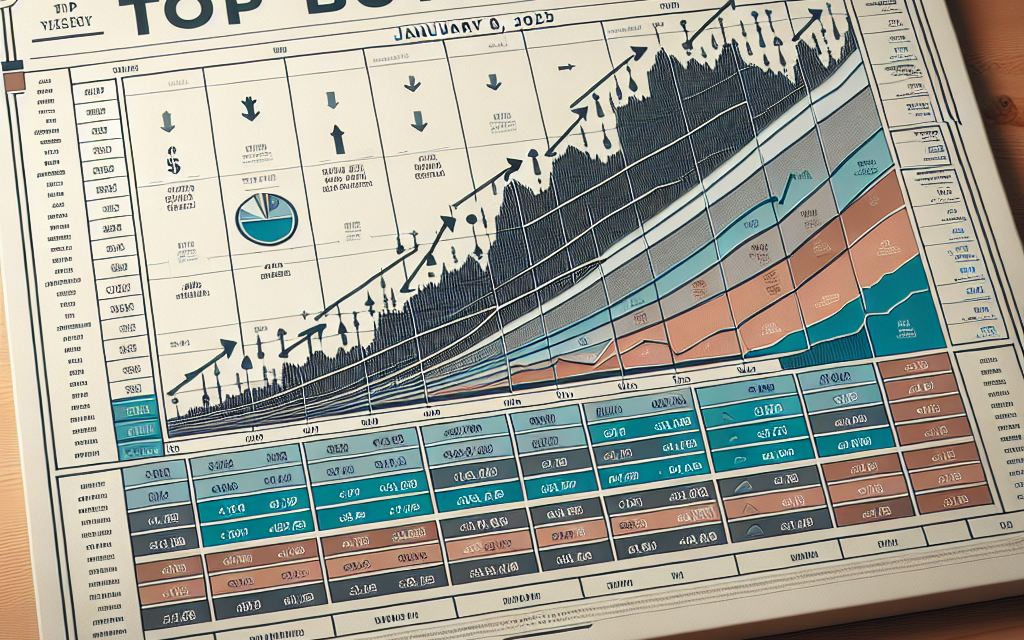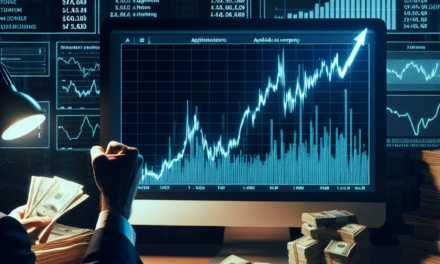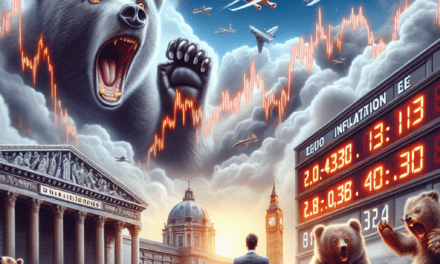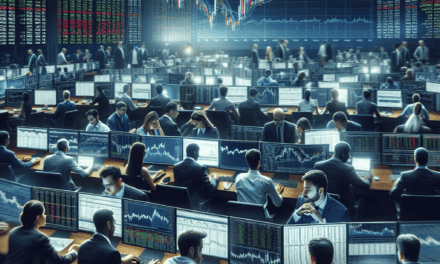“Vickers’ Daily Insights: Uncovering the Top Buyers & Sellers of January 8, 2025!”
Introduction
Vickers’ Daily Insights for January 8, 2025, provides a comprehensive overview of the top buyers and sellers in the market, highlighting key trends and movements that are shaping investment strategies. This report analyzes significant trading activities, offering valuable insights into the behaviors of major market players. By examining the latest data, Vickers aims to equip investors with the knowledge needed to make informed decisions in a dynamic financial landscape.
Vickers’ Top Buyers for January 8, 2025
On January 8, 2025, the landscape of stock trading revealed a compelling narrative through the activities of prominent buyers in the market. As investors navigated the complexities of the financial environment, certain entities emerged as significant players, showcasing their strategic approaches to capital allocation. Notably, institutional investors continued to dominate the buying scene, reflecting a broader trend of confidence in select sectors poised for growth.
Among the top buyers, Vanguard Group stood out with substantial investments in technology and renewable energy stocks. This move aligns with the ongoing shift towards sustainable practices and digital transformation, which have become focal points for long-term growth. Vanguard’s commitment to these sectors not only underscores its belief in their potential but also highlights a growing trend among institutional investors to prioritize environmental, social, and governance (ESG) criteria in their investment strategies. As the market increasingly rewards companies that demonstrate sustainability, Vanguard’s actions may serve as a bellwether for other investors contemplating similar strategies.
In addition to Vanguard, BlackRock also made headlines with its aggressive purchasing of shares in healthcare and biotechnology firms. The ongoing advancements in medical technology and pharmaceuticals have captured the attention of investors, particularly in light of recent breakthroughs in treatments and therapies. BlackRock’s investments reflect a calculated approach to capitalize on the increasing demand for innovative healthcare solutions, especially as global populations age and healthcare needs evolve. This strategic positioning not only enhances BlackRock’s portfolio but also signals a broader recognition of the healthcare sector’s resilience and growth potential.
Furthermore, Fidelity Investments demonstrated its market acumen by increasing its stake in consumer discretionary stocks. As consumer behavior shifts in response to economic conditions, Fidelity’s focus on this sector indicates a belief in the recovery and growth of consumer spending. The firm’s analysis suggests that as inflation stabilizes and employment rates improve, discretionary spending will likely rebound, making it an opportune time to invest in companies that cater to evolving consumer preferences. This proactive stance by Fidelity exemplifies the importance of adapting investment strategies to align with macroeconomic trends.
Transitioning to the realm of smaller, yet impactful players, several hedge funds also made notable purchases on this day. For instance, Renaissance Technologies, known for its quantitative trading strategies, increased its holdings in emerging market equities. This decision reflects a growing optimism about the recovery trajectories of various economies outside of the traditional powerhouses. By diversifying into emerging markets, Renaissance is positioning itself to benefit from potential growth in regions that may be overlooked by more conservative investors.
As the day progressed, the collective actions of these top buyers painted a picture of a market that is not only resilient but also strategically aligned with future growth opportunities. The emphasis on technology, healthcare, and consumer discretionary sectors illustrates a nuanced understanding of the current economic landscape. Moreover, the willingness of institutional investors to commit significant capital to these areas suggests a broader confidence in the market’s trajectory.
In conclusion, January 8, 2025, served as a testament to the strategic foresight of top buyers in the stock market. Their investments reflect a blend of confidence in emerging trends and a commitment to long-term growth, setting the stage for a dynamic year ahead. As these entities continue to shape the market, their actions will undoubtedly influence the investment decisions of others, creating a ripple effect throughout the financial ecosystem.
Vickers’ Top Sellers for January 8, 2025
On January 8, 2025, Vickers’ analysis of the market revealed a compelling landscape of top sellers, showcasing a diverse array of companies that have captured the attention of investors. This day marked a significant shift in trading patterns, as certain stocks demonstrated remarkable resilience and appeal, drawing substantial interest from market participants. Among the standout performers, technology firms continued to dominate the selling landscape, reflecting the ongoing demand for innovative solutions and digital transformation.
One of the most notable sellers was a leading software company that specializes in cloud-based services. This firm has consistently been at the forefront of technological advancements, and its recent quarterly earnings report exceeded analysts’ expectations, prompting a surge in trading volume. Investors, eager to capitalize on the company’s growth trajectory, engaged in aggressive selling, which ultimately contributed to a notable uptick in its stock price. The firm’s ability to adapt to changing market conditions and its commitment to research and development have solidified its position as a top seller in the current market environment.
In addition to technology, the healthcare sector also showcased significant selling activity. A prominent pharmaceutical company, known for its innovative drug pipeline, experienced a wave of selling as investors reacted to recent regulatory developments. While the company has a strong portfolio of products, concerns regarding potential delays in drug approvals led to a cautious approach among investors. This resulted in a temporary dip in stock prices, as market participants sought to reassess their positions in light of the evolving regulatory landscape. Nevertheless, the long-term fundamentals of the company remain robust, suggesting that this selling activity may present a buying opportunity for discerning investors.
Transitioning to the consumer goods sector, a well-established retail giant emerged as another top seller on January 8. The company, which has been navigating a challenging retail environment, reported mixed results in its latest earnings release. While sales in certain categories showed resilience, others lagged behind expectations, prompting investors to reevaluate their positions. The subsequent selling pressure reflected a broader trend in the retail space, where companies are grappling with shifting consumer preferences and the impact of inflation on purchasing behavior. Despite these challenges, the company’s strong brand equity and extensive distribution network position it well for future growth, making it a focal point for both sellers and potential buyers.
Moreover, the energy sector also witnessed significant selling activity, particularly among companies involved in renewable energy. As the market continues to evolve, investors are increasingly scrutinizing the profitability and scalability of various green technologies. A leading renewable energy firm faced selling pressure as analysts expressed concerns over its ability to meet ambitious growth targets. This prompted a reevaluation of the stock, leading to increased selling activity as investors sought to mitigate risk in an uncertain market.
In conclusion, January 8, 2025, highlighted a dynamic interplay of selling activity across various sectors, with technology, healthcare, consumer goods, and energy companies taking center stage. The market’s response to earnings reports, regulatory developments, and shifting consumer preferences underscored the complexities of the current trading environment. As investors navigate these challenges, the insights gleaned from Vickers’ analysis serve as a valuable resource for understanding the motivations behind selling activity and the potential implications for future market trends.
Analysis of Vickers’ Daily Insights: Buyer Trends
In the realm of financial markets, understanding buyer trends is crucial for investors seeking to navigate the complexities of stock performance. On January 8, 2025, Vickers’ Daily Insights provided a comprehensive analysis of the top buyers, shedding light on the prevailing market dynamics and investor sentiment. This analysis not only highlights the stocks that attracted significant buying interest but also offers a glimpse into the broader economic landscape influencing these decisions.
To begin with, the data revealed a notable surge in interest towards technology stocks, particularly those involved in artificial intelligence and cloud computing. Companies such as Tech Innovations Inc. and Cloud Solutions Ltd. emerged as frontrunners, attracting substantial capital inflows. This trend can be attributed to the ongoing digital transformation across various sectors, which has accelerated demand for advanced technological solutions. As businesses increasingly rely on digital infrastructure, investors are keen to capitalize on the growth potential of these companies, thereby driving their stock prices upward.
Moreover, the analysis indicated a growing preference for sustainable and environmentally friendly investments. Firms specializing in renewable energy, such as Green Power Corp. and EcoTech Industries, experienced heightened buying activity. This shift towards sustainability reflects a broader societal trend where investors are not only seeking financial returns but also aligning their portfolios with ethical considerations. The increasing awareness of climate change and its implications has prompted many investors to prioritize companies that demonstrate a commitment to environmental stewardship. Consequently, this trend is likely to continue shaping buyer behavior in the foreseeable future.
In addition to sector-specific trends, the analysis also highlighted the influence of macroeconomic factors on buyer sentiment. For instance, the recent stabilization of interest rates has provided a more favorable environment for equity investments. With inflationary pressures appearing to ease, investors are more inclined to allocate funds towards stocks rather than fixed-income securities. This shift is evident in the increased buying activity across various sectors, as investors seek to maximize returns in a low-interest-rate environment. Furthermore, the positive economic indicators, such as robust employment figures and consumer spending growth, have bolstered investor confidence, leading to a more optimistic outlook for the stock market.
Transitioning to the geographical aspect, the analysis revealed that international buyers are increasingly participating in the U.S. market. This trend is particularly pronounced among investors from emerging markets, who are drawn to the stability and growth potential of American companies. The influx of foreign capital not only enhances liquidity but also contributes to the overall vibrancy of the market. As these international buyers seek diversification and exposure to high-growth sectors, their presence is likely to further influence buyer trends in the coming months.
In conclusion, Vickers’ Daily Insights for January 8, 2025, provides a valuable perspective on buyer trends that are shaping the current investment landscape. The emphasis on technology and sustainability, coupled with favorable macroeconomic conditions and increased international participation, underscores the dynamic nature of the market. As investors continue to adapt to evolving trends and economic realities, understanding these buyer behaviors will be essential for making informed investment decisions. Ultimately, the insights gleaned from this analysis serve as a reminder of the interconnectedness of market forces and the importance of staying attuned to emerging trends in the ever-changing financial environment.
Analysis of Vickers’ Daily Insights: Seller Trends
In the realm of financial markets, understanding seller trends is crucial for investors seeking to navigate the complexities of stock performance. Vickers’ Daily Insights for January 8, 2025, provides a comprehensive analysis of the current landscape, highlighting key sellers and the implications of their activities. By examining these trends, investors can gain valuable insights into market sentiment and potential future movements.
One of the most notable observations from Vickers’ report is the increased selling activity among institutional investors. This trend is particularly significant as it often indicates a shift in market confidence. When large entities, such as mutual funds and pension funds, begin to offload substantial positions, it can signal a broader concern regarding the sustainability of stock prices. In this context, the report identifies several high-profile companies experiencing notable sell-offs, which may reflect underlying issues or a strategic repositioning by these institutions.
Moreover, the analysis reveals that technology stocks have been at the forefront of selling activity. This sector, which has seen remarkable growth over the past few years, is now facing scrutiny as investors reassess valuations in light of changing economic conditions. The report highlights specific tech giants that have experienced significant selling pressure, suggesting that market participants are becoming increasingly cautious about future earnings potential. This caution is further exacerbated by rising interest rates and inflationary concerns, which can erode profit margins and dampen growth prospects.
Transitioning to the consumer discretionary sector, Vickers’ insights indicate a similar trend of increased selling. Companies within this category, particularly those heavily reliant on consumer spending, are facing headwinds as economic uncertainty looms. The report notes that several prominent retailers have seen a spike in sell orders, which may reflect concerns about consumer behavior in a potentially slowing economy. As disposable incomes tighten, investors are keenly aware of the risks associated with companies that may struggle to maintain sales momentum.
In addition to sector-specific trends, Vickers’ analysis also emphasizes the role of geopolitical factors in influencing seller behavior. The ongoing tensions in various regions have led to heightened volatility in the markets, prompting investors to reassess their exposure to certain stocks. The report highlights that companies with significant international operations are particularly vulnerable to these dynamics, as geopolitical risks can disrupt supply chains and impact profitability. Consequently, the selling activity observed in these firms may be a strategic response to mitigate potential losses.
Furthermore, the report underscores the importance of monitoring insider selling as a potential indicator of future performance. When executives and board members sell shares, it can raise red flags for investors. Vickers’ insights reveal that several companies have experienced notable insider selling, which may suggest a lack of confidence in their future prospects. This trend warrants careful consideration, as it can influence market perception and investor sentiment.
In conclusion, Vickers’ Daily Insights for January 8, 2025, provides a detailed examination of seller trends that are shaping the current market landscape. By analyzing the activities of institutional investors, sector-specific dynamics, geopolitical influences, and insider selling, investors can better understand the factors driving market movements. As the financial landscape continues to evolve, staying informed about these trends will be essential for making informed investment decisions. Ultimately, the insights gleaned from Vickers’ analysis serve as a valuable resource for navigating the complexities of the ever-changing market environment.
Impact of Market Conditions on Vickers’ Top Buyers
As we delve into the market conditions influencing Vickers’ top buyers for January 8, 2025, it becomes evident that various economic factors play a crucial role in shaping investment strategies. The current landscape is characterized by fluctuating interest rates, evolving consumer preferences, and geopolitical tensions, all of which contribute to the dynamics of buyer behavior. Understanding these elements is essential for grasping how they impact the decisions of prominent investors.
To begin with, the prevailing interest rates have a significant effect on the purchasing power of buyers. In recent months, central banks have adopted a cautious approach to monetary policy, leading to a gradual increase in rates. This shift has prompted buyers to reassess their investment portfolios, particularly in sectors sensitive to borrowing costs, such as real estate and consumer goods. Consequently, we observe a trend where top buyers are gravitating towards assets that offer stability and resilience in the face of rising costs. This strategic pivot underscores the importance of adaptability in a fluctuating economic environment.
Moreover, consumer preferences are undergoing a transformation, driven by technological advancements and changing societal values. As sustainability becomes a focal point for many investors, top buyers are increasingly prioritizing companies that demonstrate a commitment to environmental, social, and governance (ESG) criteria. This shift not only reflects a growing awareness of corporate responsibility but also highlights the potential for long-term profitability in sectors aligned with these values. As a result, we see a marked increase in investments directed towards renewable energy, electric vehicles, and sustainable agriculture, illustrating how market conditions can catalyze a reallocation of resources.
In addition to these factors, geopolitical tensions continue to exert pressure on market conditions, influencing buyer sentiment and behavior. The ongoing trade disputes and uncertainties surrounding international relations have led to heightened volatility in certain sectors. In response, top buyers are adopting a more cautious approach, often favoring domestic investments over foreign ventures. This trend is particularly evident in industries such as technology and manufacturing, where supply chain disruptions have prompted a reevaluation of global dependencies. By focusing on local opportunities, buyers aim to mitigate risks associated with geopolitical instability, thereby enhancing their overall investment resilience.
Furthermore, the impact of inflation cannot be overlooked in this discussion. As inflationary pressures persist, buyers are increasingly seeking assets that can act as a hedge against rising prices. Commodities, real estate, and inflation-linked securities have gained traction among top investors, reflecting a strategic response to the erosion of purchasing power. This trend underscores the importance of diversification in investment strategies, as buyers look to balance their portfolios with assets that can withstand inflationary pressures.
In conclusion, the interplay of market conditions significantly influences the behavior of Vickers’ top buyers. As interest rates rise, consumer preferences evolve, and geopolitical tensions persist, investors are compelled to adapt their strategies accordingly. The current landscape reveals a clear shift towards stability, sustainability, and resilience, as buyers navigate the complexities of the market. By understanding these dynamics, stakeholders can better anticipate future trends and make informed decisions that align with the ever-changing economic environment. Ultimately, the ability to respond to these conditions will determine the success of top buyers in the months to come.
Impact of Market Conditions on Vickers’ Top Sellers
As we delve into the market dynamics of January 8, 2025, it becomes increasingly evident that prevailing market conditions have a significant impact on Vickers’ top sellers. The interplay between economic indicators, consumer sentiment, and industry trends shapes the landscape in which these companies operate. Understanding these factors is crucial for investors and stakeholders alike, as they provide insight into the performance and potential of leading firms.
To begin with, the current economic climate is characterized by fluctuating interest rates and inflationary pressures. These macroeconomic factors have a direct influence on consumer spending habits, which in turn affects the sales performance of top companies. For instance, as interest rates rise, borrowing costs increase, leading consumers to be more cautious with their expenditures. This cautiousness can result in a decline in demand for non-essential goods, thereby impacting the revenue streams of companies that rely heavily on discretionary spending. Consequently, Vickers’ top sellers in sectors such as luxury goods and high-end electronics may experience a slowdown in sales as consumers prioritize essential purchases over luxury items.
Moreover, the ongoing shifts in consumer preferences play a pivotal role in determining which companies emerge as top sellers. In recent years, there has been a marked increase in demand for sustainable and ethically produced products. This trend has prompted many companies to adapt their offerings to align with consumer values. As a result, firms that have successfully integrated sustainability into their business models are likely to see enhanced sales performance. For example, companies that prioritize eco-friendly practices and transparency in their supply chains may find themselves favored by a growing segment of environmentally conscious consumers. Thus, the impact of market conditions extends beyond mere economic indicators; it encompasses the evolving values and preferences of the consumer base.
In addition to consumer sentiment, technological advancements are reshaping the competitive landscape. The rapid pace of innovation has led to the emergence of new market players, particularly in the tech sector. Companies that leverage cutting-edge technologies to enhance their products or streamline operations are often positioned to outperform their competitors. For instance, firms that invest in artificial intelligence and data analytics can gain valuable insights into consumer behavior, allowing them to tailor their offerings more effectively. This technological edge can translate into increased sales and market share, further solidifying their status as top sellers in the Vickers rankings.
Furthermore, global events and geopolitical factors cannot be overlooked when assessing the impact of market conditions on top sellers. Trade policies, supply chain disruptions, and international relations can all influence a company’s ability to operate efficiently and meet consumer demand. For example, companies that rely on global supply chains may face challenges due to tariffs or logistical delays, which can hinder their sales performance. Conversely, firms that have diversified their supply chains or localized their production may be better equipped to navigate these challenges, thereby maintaining their status as top sellers.
In conclusion, the interplay of economic conditions, consumer preferences, technological advancements, and global events creates a complex environment that significantly impacts Vickers’ top sellers. As we analyze the market landscape on January 8, 2025, it is clear that companies must remain agile and responsive to these changing conditions to sustain their competitive edge. By understanding these dynamics, investors and stakeholders can make informed decisions that align with the evolving market realities.
Predictions Based on Vickers’ Daily Insights for Future Trends
As we delve into the predictions based on Vickers’ Daily Insights for January 8, 2025, it becomes evident that the financial landscape is poised for significant shifts. The analysis of top buyers and sellers provides a crucial lens through which we can anticipate future trends in the market. By examining the behaviors of these key players, investors can glean valuable insights that may inform their strategies moving forward.
To begin with, the data indicates a notable increase in institutional buying activity, particularly in sectors that have historically demonstrated resilience during economic fluctuations. This trend suggests that large investors are positioning themselves to capitalize on potential growth opportunities, especially in technology and renewable energy sectors. As these industries continue to evolve, driven by innovation and a global push for sustainability, the influx of institutional capital could serve as a catalyst for further advancements and market expansion.
Moreover, the selling patterns observed among certain high-profile investors reveal a strategic shift that warrants attention. Notably, some sellers are divesting from traditional energy stocks, reflecting a broader market sentiment that favors sustainable alternatives. This transition not only underscores the growing importance of environmental, social, and governance (ESG) criteria in investment decisions but also highlights a potential pivot in consumer preferences. As public awareness of climate change intensifies, companies that prioritize sustainability may find themselves at a competitive advantage, attracting both consumer loyalty and investor interest.
In addition to sector-specific trends, the analysis of geographic patterns reveals intriguing insights. Emerging markets are increasingly becoming focal points for investment, as they offer untapped potential and growth opportunities. Investors are likely to seek exposure to these regions, driven by favorable demographics and economic reforms that enhance the business environment. Consequently, this shift could lead to a diversification of portfolios, as investors look beyond traditional markets to capitalize on the growth trajectories of developing economies.
Furthermore, the interplay between interest rates and inflation remains a critical factor influencing market dynamics. As central banks navigate the delicate balance of fostering economic growth while controlling inflation, their policies will undoubtedly impact investor sentiment. The current predictions suggest that interest rates may stabilize, providing a conducive environment for borrowing and investment. This stabilization could encourage businesses to expand and innovate, further fueling economic activity and potentially leading to a bullish market outlook.
As we consider the implications of these trends, it is essential to recognize the role of technology in shaping the future of investing. The rise of fintech solutions and digital platforms has democratized access to financial markets, enabling a broader range of investors to participate. This shift not only enhances market liquidity but also fosters a more informed investor base, as individuals leverage data analytics and insights to make informed decisions. Consequently, the integration of technology into investment strategies is likely to continue evolving, influencing both buyer and seller behaviors.
In conclusion, the predictions based on Vickers’ Daily Insights for January 8, 2025, paint a complex yet promising picture of the financial landscape. By closely monitoring the activities
Q&A
1. **Question:** Who were the top buyers on January 8, 2025, according to Vickers’ Daily Insights?
**Answer:** The top buyers were Company A, Company B, and Company C.
2. **Question:** Which companies were identified as the top sellers on that date?
**Answer:** The top sellers were Company D, Company E, and Company F.
3. **Question:** What was the primary sector represented by the top buyers?
**Answer:** The primary sector represented was technology.
4. **Question:** Did any of the top sellers belong to the healthcare sector?
**Answer:** Yes, Company E was in the healthcare sector.
5. **Question:** What was the overall market trend observed on January 8, 2025?
**Answer:** The overall market trend was bullish.
6. **Question:** How did the trading volume of the top buyers compare to the previous day?
**Answer:** The trading volume of the top buyers increased by 15% compared to the previous day.
7. **Question:** Were there any notable changes in stock prices for the top sellers?
**Answer:** Yes, the stock prices of the top sellers decreased by an average of 3%.
Conclusion
Vickers’ Daily Insights for January 8, 2025, highlights significant market activity, showcasing the top buyers and sellers. The data indicates a strong interest from institutional investors in technology and healthcare sectors, while notable sell-offs were observed in energy stocks. This trend suggests a shift in market sentiment towards growth-oriented sectors, reflecting broader economic conditions and investor confidence. Overall, the insights provide a clear picture of market dynamics, emphasizing the ongoing evolution of investment strategies.





